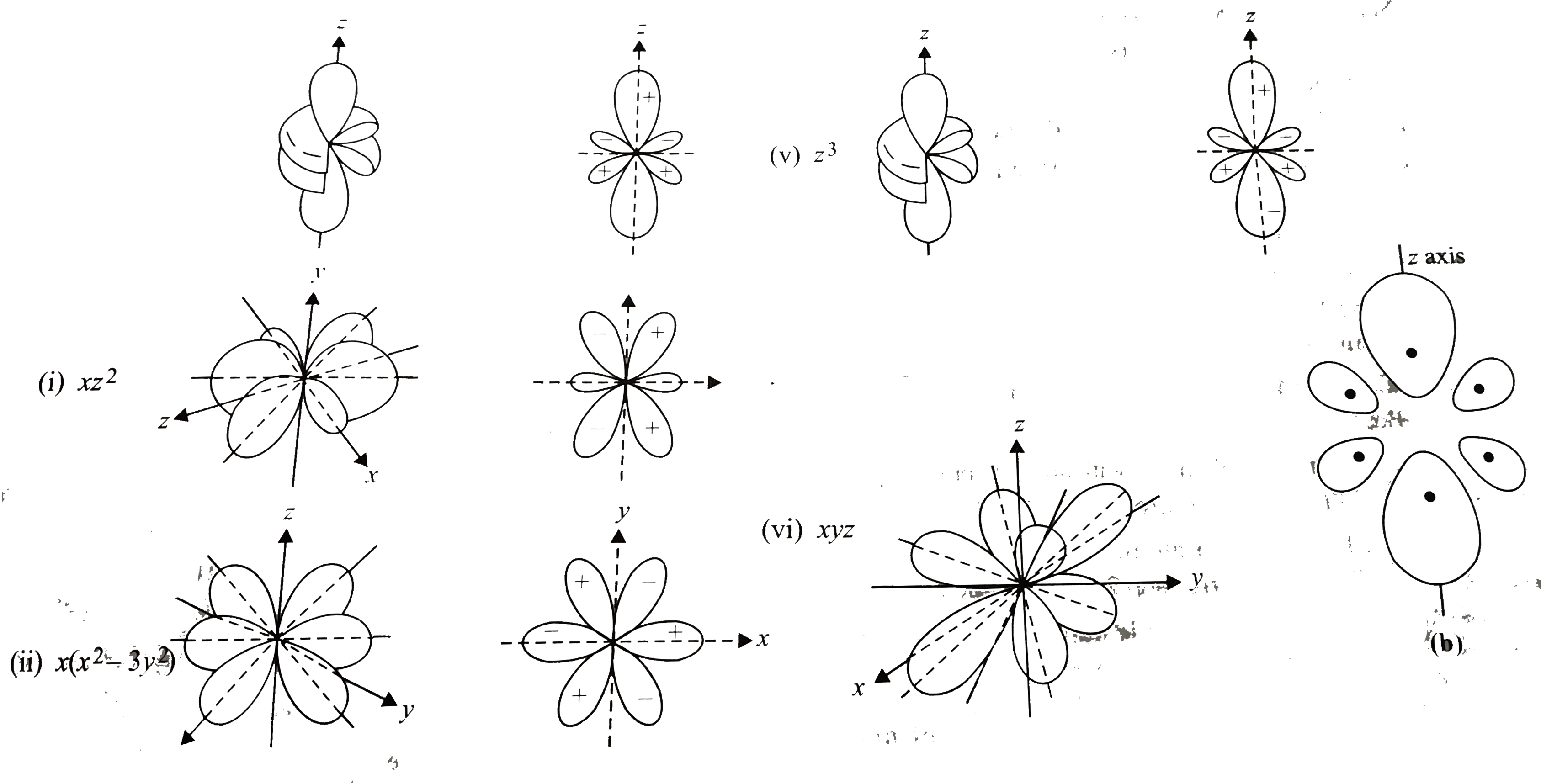Give the names of seven f-orbitals and how they are represented.
A complete set of seven f-orbitals is shown in the table and the figure given here.

(i) 
(iii) y(3y2−x2) Same as x(x2−3y2) except lies along the y axis.
(iv) z(x2−y2)xyz} Same as the corresponding orbitals in the cubic set.
As with d-orbitals, there is no unique way of representing them, nor is there even a way which is optimum for all problems.
The figure presents two sets, 'General set' and a 'cubic set'. The latter is advantageous in considering the properties of the orbitals in cubic (i.e., octahedral and tetrahedral fields).
(vii) z(x2−y2)y(z2−x2)x(z2−y2)⎫⎪
⎪⎬⎪
⎪⎭Same as the xyz but rotated45∘about the x, y and z axe
Topper's Solved these Questions
- PERIODIC CLASSIFICATION OF ELEMENTS AND GENERAL INORGANIC CHEMISTRYBOOK - CENGAGE CHEMISTRYCHAPTER - PERIODIC CLASSIFICATION OF ELEMENTS AND GENERAL INORGANIC CHEMISTRYEXERCISE - Ex 1.1
14 Videos
- PERIODIC CLASSIFICATION OF ELEMENTS AND GENERAL INORGANIC CHEMISTRYBOOK - CENGAGE CHEMISTRYCHAPTER - PERIODIC CLASSIFICATION OF ELEMENTS AND GENERAL INORGANIC CHEMISTRYEXERCISE - Ex 1.1 (Very Short)
22 Videos
- PERIODIC CLASSIFICATION OF ELEMENTS AND GENERAL INORGANIC CHEMISTRYBOOK - CENGAGE CHEMISTRYCHAPTER - PERIODIC CLASSIFICATION OF ELEMENTS AND GENERAL INORGANIC CHEMISTRYEXERCISE - Exercises (Archives )Subjective
4 Videos
- P-BLOCK GROUP 14 - CARBON FAMILYBOOK - CENGAGE CHEMISTRYCHAPTER - P-BLOCK GROUP 14 - CARBON FAMILYEXERCISE - Exercises Archives (Subjective)
9 Videos
- PURIFICATION OF ORGANIC COMPOUNDS AND QUALITATIVE AND QUANTITATIVE ANALYSISBOOK - CENGAGE CHEMISTRYCHAPTER - PURIFICATION OF ORGANIC COMPOUNDS AND QUALITATIVE AND QUANTITATIVE ANALYSISEXERCISE - Assertion Reasoning Type
5 Videos
Similar Questions
Write the names of seven angles in the given diagram

View SolutionElectrons revolve around the nucleus in fixed orbits or shells called energy levels'. State how these energy levels are represented.
View Solutiona. In the sixth period, after filling of 6p orbitals, the next electron (i.e. 57th) enters the 5d-orbital against aufbau principal and there after the filling of seven 4f-orbitals starts with cerium (Z=71). Explain this anomalous behaviour.
b. In the seventh period, after the filling of 7s-orbital, the next two electrons (i.e. 89th and 90th) enter the 6d-orbital against Aufbau principle and there after the filling of seven 5f-orbitals begins with proactinium (Pr,Z=91) and ends up with lawrencium (Lr,Z=103). Explain this anomalous behaviour.
View SolutionThe shapes of orbital may be represented by boundary surface diagrams. These boundary surface diagram give the most probable regions. S-orbitals are non-directional while p-, d- and f-orbitals have different orientations given by ml values. These boundary surfaces also have sperical nodes or radial nodes and nodal planes which depend upon the values of n and l.
How many angular nodes are present in 3dyz orbital?
View Solutiona. In the sixth period, after filling of 6p orbitals, the next electron (i.e. 57th) enters the 5d-orbital against aufbau principal and there after the filling of seven 4f-orbitals starts with cerium (Z=71). Explain this anomalous behaviour.
View SolutionGive the IUPAC name of the hydrocarbon represented by Swastik sign.
View SolutionGive the IUPAC name of the hydrocarbon represented by Swastik sign.
View SolutionThe shapes of orbital may be represented by boundary surface diagrams. These boundary surface diagram give the most probable regions. S-orbitals are non-directional while p-, d- and f-orbitals have different orientations given by ml values. These boundary surfaces also have sperical nodes or radial nodes and nodal planes which depend upon the values of n and l.
How do 3s and 4s orbitals differ in terms of nodes present in these ?
View SolutionGive the scientific name of filarial worm. How is it spread from man to man?
View SolutionHow many nodes are there in 5f orbitals?
View Solution
